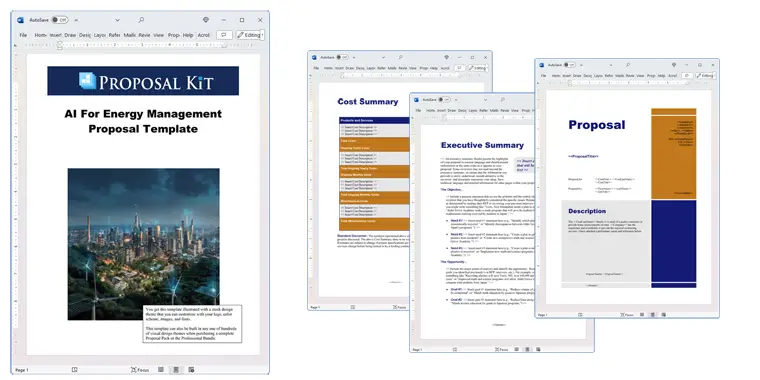How to write your AI For Energy Management Proposal Template
We include this 20 page layout with every Proposal Pack. If you want this template to have a different visual design theme than the one illustrated here, purchase any Proposal Pack design and create this template using the purchased design theme. This template is included in every Proposal Pack. If you get a Proposal Pack or the Professional, you can also make any variation of this template with different chapters to suit your needs.
We typically include more chapters in the templates than most people will need to give everyone more variety in the chapters they may need. You can trim down a long template by removing pages you do not need or combining multiple chapter topics into one page.
 DOWNLOADABLE, ONE-TIME COST, NO SUBSCRIPTION FEES
DOWNLOADABLE, ONE-TIME COST, NO SUBSCRIPTION FEESYou can also create countless variations of this document to suit your needs using the included library of 2200+ chapters if ordering a Proposal Pack or Professional.
 What Our Clients Say
What Our Clients SayYour Proposal Packs summarize in the best of fashion all the finest practices for businesses in their dealings with customers, mostly because they remain focused on the client’s solution, giving back to the customer the control over his project."
e-nstitute, Inc.
Related Article
Related Video
Related Templates
- Technology Strategy Analysis
- Artificial Intelligence Proposal Template
- AI Proposal Template
- Artificial Intelligence Project Funding Proposal
- Software Beta Testing Project Proposal
- Software System Testing Project Proposal
- Software Automation Proposal
- Software and Hardware System Proposal
- Software as a Service (SAAS) Proposal
- Custom Software Development Proposal
- Defense Contracting Intelligence System Proposal
- Mobile App Software Development Proposal
- Cloud Computing Services Proposal
- Environmental Program Proposal
- Solar Power System Grid and Storage Proposal
- Energy Efficiency Grant Project Proposal
What's the best way to write your AI for an energy management proposal?
If you need to create an AI-based energy management proposal, using the Proposal Kit template and software package is the proven solution. Proposal Kit makes the process efficient, fast, and effective - whether you're a small startup, a large corporation, or a consulting provider looking to showcase your ability to integrate Artificial Intelligence into energy management systems. With its comprehensive template library, Proposal Kit covers every topic of your custom project, allowing you to highlight innovative strategies for boosting efficiency in building operations, urban planning, and beyond.
Proposal Kit offers more than just templates. It includes a powerful line item quoting database for seamless cost summaries, quotes, estimates, and budgets. This ensures your financial information is always clear and professional. Plus, with the integrated AI Writer, you can generate a personalized first write tailored to your company's unique needs in just minutes, taking your project details and recipient information into account. To round out your proposal, Proposal Kit also provides a PowerPoint conversion feature - using the same AI Writer to quickly create a ready-to-present PowerPoint slideshow from your finished document.
Are you facing the task of writing a proposal for an AI-driven energy management project or another sustainability-focused initiative? Perhaps your organization needs to streamline energy use, cut costs, and lower its carbon footprint. If this sounds like your situation, the Proposal Kit is specifically designed to help you succeed.
What Types of Projects Are AI For Energy Management Proposal Written For?
AI-driven energy management proposals are important for a growing range of projects that combine technology and sustainability. These proposals are written to address needs in various industries, public sectors, and private enterprises, all aiming to improve efficiency, cut costs, and reduce environmental impact using intelligent solutions. Here are some examples of projects where such proposals are commonly required:
- Smart building automation and energy control systems
- Predictive maintenance for HVAC and energy infrastructure
- AI-powered energy consumption optimization for large campuses
- Renewable energy integration into municipal power grids
- Real-time energy monitoring for manufacturing plants
- AI-based demand response solutions for utilities
- Automated lighting and climate control systems in office towers
- Urban planning for smart cities using AI-driven analytics
- Energy asset management for distributed solar or wind farms
- AI-supported load balancing for electrical grids
- Carbon footprint tracking and reduction initiatives
- Energy-efficient retrofitting of existing structures with AI guidance
- Smart meter data analytics for residential energy savings
- Electric vehicle (EV) fleet energy optimization
- AI-driven water heating and cooling management in hotels
- Microgrid energy management using AI algorithms
- Automated energy compliance reporting for government contracts
- AI-based forecasting of renewable energy production
- Smart home energy management solutions
- Sustainability planning for corporate campuses using AI analysis
Chapters this template is built with
There is no one-size-fits-all premade template that works for every situation. However, Proposal Kit's software creates custom variations of templates that can be tailored to any project. With thousands of chapters in its library, you can build a unique proposal that covers every topic relevant to your AI-focused energy management initiative. Below is a small sample of chapter templates from Proposal Kit's library, each suited for use in an AI energy efficiency proposal. Each chapter is a customizable Word document you can use to address specific areas of your project.
Cover Letter
In an AI for energy management proposal, the Cover Letter serves as your first impression. Here, you specifically address the recipient - be it a city planner, building owner, or board member - summarizing your understanding of their unique challenges. You can highlight your experience with AI integration in energy systems, touch on past successes, and set the stage for the innovative solutions detailed inside. The Cover Letter is the place to clearly state the value you bring and to establish a sense of partnership and purpose from the outset.
Title Page
The Title Page is the formal front of your proposal. For an AI-based energy management bid, this page will prominently display the project name, your company's branding, the client's name, and key dates. Customizing the Title Page shows professionalism and helps your proposal stand out, especially when multiple bids are being considered.
Table of Contents
A well-structured Table of Contents is important in lengthy AI-powered energy optimization proposals. This section lays out all included chapters, making it easy for reviewers to find vital sections like technical details, cost savings, or implementation plans. It demonstrates an organized approach - a quality valued in complex technology projects.
Introduction
The Introduction sets the scene by describing current trends and priorities in sustainable energy management. In your AI-driven proposal, use this chapter to highlight the importance of integrating automation and data intelligence. Explain how your approach will directly address the client's business goals, increase efficiency, and contribute to environmental stewardship.
Executive Summary
The Executive Summary distills your entire proposal into a concise, compelling narrative. Considering the situation of AI for energy management, this section gives decision-makers a snapshot of your solution's technical and financial benefits, projected outcomes, and the key reasons your team is the ideal choice to deliver results. It should entice the reader to look further into the full proposal.
Needs Assessment
Within the Needs Assessment, you identify specific operational, financial, or environmental pain points faced by the client. For instance, you might detail how fluctuating energy costs, inefficient systems, or regulatory pressures can be solved using AI tools. This helps the recipient see you understand their situation on a granular level.
Goals and Objectives
The Goals and Objectives chapter outlines what your AI energy management proposal intends to achieve. These could include targets like reducing energy consumption by 20%, achieving certain sustainability certifications, or automating 90% of building system controls. Clear objectives provide measurable benchmarks for project success.
Energy
In the Energy chapter, you analyze current energy usage, sources, and patterns within the client's facility or city. For AI projects, this often includes baseline measurements gathered from smart meters or IoT sensors, which sets the stage for demonstrating the improvements AI will bring.
Artificial Intelligence
This chapter focuses on the AI technologies and methodologies you'll implement. You might describe specific algorithms for predictive analytics, machine learning platforms, or integration with IoT devices. Use this section to explain why your chosen AI tools are ideal for optimizing the client's energy management systems.
Autonomous Operation
Autonomous Operation discusses how your AI systems can automate processes such as adjusting heating/cooling, load balancing, or running diagnostics with minimal human intervention. Explain how this leads to consistent energy savings, fewer errors, and ongoing improvements without additional staffing.
Efficiency
The Efficiency chapter quantifies the expected gains. In an AI for energy management proposal, detail how your system will outperform legacy setups - such as reducing peak demand, optimizing equipment performance, or minimizing energy waste during off-hours. Include real-world benchmarks or case studies if possible.
Technology
Here, you provide a technical overview of the hardware and software components being proposed. This could include smart sensors, cloud-based analytics, edge computing devices, and dashboard interfaces. Explain compatibility with existing infrastructure and scalability for future expansion.
Environmental Impact
This chapter allows you to address regulatory and reputational concerns by quantifying the expected reductions in carbon emissions, water use, or other environmental metrics. Detail how AI will automate compliance reporting and help the client meet or exceed environmental standards.
Implementation Plan
The Implementation Plan breaks down every phase of the project - such as system assessment, pilot testing, full deployment, training, and ongoing support. Include a timeline with key milestones and deliverables, giving clients confidence that your team has a clear, actionable strategy.
Project Management
Project Management details your team structure, roles and responsibilities, and coordination with the client's staff. In an AI energy management context, highlight your experience managing technology rollouts, data integration, and cross-departmental collaboration to ensure timely, on-budget delivery.
Cost Savings
Use this chapter to showcase the financial benefits of your AI-driven proposal. Provide data-backed projections of utility bill reductions, maintenance savings, and long-term return on investment. Include tables or models that make your cost analysis clear and persuasive.
Recommendations
The Recommendations chapter is where you offer tailored suggestions for maximizing the benefits of AI in energy management. You might propose additional enhancements, like integrating renewable sources or expanding to multi-site management, based on your assessment of the client's needs and future goals.
Company History
Company History provides a narrative of your organization's experience with similar projects. Highlight successful deployments of AI in energy management, cite client testimonials, and mention partnerships that position you as a trusted expert in smart technology solutions.
Credentials
Credentials showcase your team's certifications - such as LEED accreditation, AI engineering qualifications, or vendor partnerships. Also, include case studies and awards that demonstrate your proven ability to deliver sophisticated energy-saving solutions.
Back Page
The Back Page serves as your proposal's closing chapter. Here, you typically list company contact details, legal disclaimers, or next steps for the client. In an AI for energy management proposal, you may also include QR codes linking to demo videos or digital portfolios to leave a lasting, interactive impression.
Use cases for this template
Gaining City Council Approval for Smart Energy Urban Transformation
The Challenge
Skyline City Planners had a bold goal: make their growing metropolitan district a beacon of energy efficiency and sustainable growth. The team's vision revolved around weaving Artificial Intelligence into every topic of the city's energy grid and future urban planning. Yet, despite the clear need, skepticism among city stakeholders loomed large. Convincing council members, financial backers, and department heads to move forward with such a technology-forward initiative meant producing a proposal that could bridge the gap between visionary innovation and practical, responsible investment.
The Solution
Recognizing the need for a thoroughly professional and easy-to-understand proposal, the lead planner turned to Proposal Kit's template software. By selecting tailored chapter templates for urban planning, AI integration, and environmental sustainability, the planner could clearly map out how the proposed AI-driven systems would work. The built-in line item quoting system was used to break down anticipated costs, create detailed budgets, and demonstrate long-term savings, making a financial case for the project.
The Implementation
To personalize the proposal, the planner used Proposal Kit's AI Writer, inputting Skyline's vision, specific energy use challenges, and details about the key decision-makers. The AI Writer generated well-structured write sections, which were then edited for clarity and tailored to address the council's priorities. Once the core proposal was finalized, the planner used the PowerPoint creation feature to develop a dynamic, visually engaging slideshow. This presentation distilled the most vital information, making it easily digestible for council meetings.
The Outcome
The city council was swiftly impressed with the thoroughness and clarity of the written proposal, which provided both technical depth and accessible summaries. The corresponding PowerPoint presentation delivered a powerful visual narrative, emphasizing the city's potential transformation and the measurable benefits of AI-based energy management. The professionalism enabled by Proposal Kit's features played a central role in winning over skeptical stakeholders, leading to full project approval and funding for Skyline City Planners' innovative initiative.
Winning the University Contract with a Customized AI-Driven Energy Solution
The Challenge
QuantumGrid Solutions, an up-and-coming technology provider, was eager to secure a major contract with a well-known university. The university sought a partner to help them optimize energy use across their sprawling campus, reduce utility costs, and meet ambitious sustainability targets. The competition was fierce, and QuantumGrid had to prove both the technical merits of their AI-powered system and their ability to deliver on time and within budget - all through a proposal that would stand out from a crowded field.
The Solution
To gain an edge, QuantumGrid's proposal lead turned to Proposal Kit's extensive template library and Wizard software. By choosing template topics such as artificial intelligence, efficiency gains, cost savings, and implementation strategies, the proposal addressed each of the university's stated concerns. The built-in quoting features allowed for detailed, clear financial breakdowns - key to satisfying university procurement officers.
The Implementation
Facing a demanding timeline, the proposal writer used the AI Writer to accelerate the writing process. By feeding in QuantumGrid's website content, specific project information, and details about the university's green initiatives, the AI Writer generated text for each chapter. This allowed the team to focus their efforts on refining messaging, customizing value propositions, and ensuring technical accuracy. Once the written proposal was polished, the PowerPoint creator was used to quickly assemble a clear, concise presentation tailored for the university's board of decision-makers.
The Outcome
The end result was a proposal and presentation package that not only demonstrated technical competency but also communicated QuantumGrid's value in plain language. The board appreciated the professionally formatted document, and the PowerPoint delivered a memorable overview of cost and energy savings. By using Proposal Kit's features, QuantumGrid Solutions made a lasting impression and ultimately secured the university contract.
Creating an Effective RFP for Non-Profit Renewable Energy Advancement
The Challenge
At Green Horizons Foundation, the director was tasked with issuing a Request for Proposal (RFP) to find a partner capable of providing advanced, AI-supported monitoring for a local renewable energy project. The foundation needed to ensure that the RFP was clear, thorough, and approachable for high-quality providers, all while aligning with the organization's mission-driven values and technical requirements. The stakes were high, as the success of the project depended on attracting the right expertise.
The Solution
The director relied on the Proposal Kit to construct the RFP. By selecting specific chapter templates - covering renewable energy, AI algorithms, project management, and environmental impact - she created a document that communicated technical requirements and desired outcomes in detail. Proposal Kit's AI Writer helped translate the foundation's goals and web content into precise language, reducing writing time and ensuring the final document was both professional and accessible.
The Implementation
Efficiency was crucial, so the director used Proposal Kit's built-in tools to create a structured, clear RFP. The AI Writer provided written content for each section, which she then tailored to reflect the foundation's voice and the board's expectations. Taking advantage of the integrated PowerPoint creation feature, she developed a presentation summarizing the RFP's scope and evaluation criteria, making it easy to share with both the board and prospective bidders.
The Outcome
With both a comprehensive RFP and a visually engaging PowerPoint summary, Green Horizons Foundation was able to reach a wide pool of potential vendors. The clarity and professionalism of the documents led to a strong response, with many providers eager to participate. The board had the confidence to select the most innovative and qualified partner, setting the stage for the successful implementation of the AI-driven renewable energy monitoring system.
Conclusions and Recommendations
Creating an AI-driven energy management proposal is straightforward and effective with Proposal Kit's template library and Wizard software. Whether you are pitching cutting-edge solutions, assembling internal project proposals, or issuing RFPs, Proposal Kit helps you get the job done quickly and professionally. With features like the AI Writer for personalized drafts, a built-in quoting system for financials, and seamless PowerPoint creation, your AI-driven energy efficiency proposal will be complete, clear, and compelling for any audience.
Also Known As
This template may also be referred to in different ways or be used in more specialized situations, such as:
- AI energy optimization proposal
- Smart building energy proposal
- Artificial intelligence energy project proposal
- Automated energy management proposal
- Sustainable technology integration proposal
- Intelligent energy systems proposal
- Smart grid AI proposal
- Energy efficiency automation proposal
- AI-powered sustainability proposal
- Urban energy management proposal
Abstract
 As organizations and communities become increasingly aware of the urgent need for sustainable energy solutions, AI-driven energy management proposals have become important for addressing client pain points and meeting specific requirements in today's market. These proposals often focus on energy-saving initiatives, using AI, and the integration of renewable energy sources to reduce energy costs, greenhouse gas emissions, and overall environmental impact in both business operations and public infrastructure. By identifying key topics such as operational efficiency, inventory management, and smart grid technologies, business development teams are able to define project scope, set a clear project timeline, and align with stakeholder priorities.
As organizations and communities become increasingly aware of the urgent need for sustainable energy solutions, AI-driven energy management proposals have become important for addressing client pain points and meeting specific requirements in today's market. These proposals often focus on energy-saving initiatives, using AI, and the integration of renewable energy sources to reduce energy costs, greenhouse gas emissions, and overall environmental impact in both business operations and public infrastructure. By identifying key topics such as operational efficiency, inventory management, and smart grid technologies, business development teams are able to define project scope, set a clear project timeline, and align with stakeholder priorities.
The proposal creation process now blends human expertise with AI-generated proposals and generated content, ensuring effective proposals that maintain consistency, save time, and deliver high-quality proposals. By generating tailored content and client-specific insights based on real-time data, teams can respond to critical components such as supply chain challenges, data security, and regulatory requirements. Incorporating persuasive proposals backed by charts, graphs, and relevant case studies helps build trust with different stakeholders, increases credibility, and demonstrates a deep understanding of market trends, customer segments, and unique requirements.
To ensure winning proposals, proposal development must focus on key details such as proposed solutions, expected outcomes, and methods for reducing waste and increasing operational efficiency, particularly through the installation of solutions like solar panels and the use of smart grid and microgrid alternatives. Technological advancements - including AI agent deployment, smart home energy management, and automation of building systems - play a vital role in helping clients achieve their sustainability goals while addressing risks and ensuring quality control.
 A robust approach to content generation supports both traditional methods and digital marketing strategies, such as email marketing, ensuring easy access to customizable templates and important resources for proposal development. By maintaining consistency and tailoring documents to a specific audience, organizations can scale their services, win more deals, and foster business growth in a competitive environment. Using a combination of quality control measures, bullet points for clarity, and a well-informed team supports the development of reliable, effective, and viable energy management solutions that contribute to the community's sustainability efforts and long-run environmental resilience.
A robust approach to content generation supports both traditional methods and digital marketing strategies, such as email marketing, ensuring easy access to customizable templates and important resources for proposal development. By maintaining consistency and tailoring documents to a specific audience, organizations can scale their services, win more deals, and foster business growth in a competitive environment. Using a combination of quality control measures, bullet points for clarity, and a well-informed team supports the development of reliable, effective, and viable energy management solutions that contribute to the community's sustainability efforts and long-run environmental resilience.
In today's landscape, the growing demand for innovative energy-saving initiatives challenges organizations to create proposals that address both technical and planning needs. Using AI in proposal creation not only streamlines content creation and ensures efficiency but also allows users to generate tailored content that speaks directly to the client's specific goals and unique challenges. By analyzing client data, teams can identify areas for improvement, create problem statements with relevant details, and provide solutions that reduce waste and optimize electricity usage across diverse sectors.
The transformative impact of these AI-driven proposals extends to enhancing stakeholder engagement, supporting the community's sustainability efforts, and building trust among consumers and different stakeholders. With Proposal Kit's robust features - such as customizable templates, automated document assembly, and easy export to PDF - team members can focus on the heavy lifting of research and planning while the software handles the repetitive topics of content generation and quality control. This division of labor lets humans focus on high-value tasks, ensuring quality, inclusion, and a well-informed approach to proposal development.
 A company overview and pricing section within these proposals often highlight the organization's commitment, reliable partner status, and competitive advantage in a market size that continues to expand. Reducing technical jargon makes proposals more accessible to a broader audience, improving the customer experience and facilitating stakeholder involvement during the transition to sustainable solutions. By addressing feedback from customers and integrating diverse case studies, organizations can further refine their offerings and ensure that proposals are both effective and persuasive.
A company overview and pricing section within these proposals often highlight the organization's commitment, reliable partner status, and competitive advantage in a market size that continues to expand. Reducing technical jargon makes proposals more accessible to a broader audience, improving the customer experience and facilitating stakeholder involvement during the transition to sustainable solutions. By addressing feedback from customers and integrating diverse case studies, organizations can further refine their offerings and ensure that proposals are both effective and persuasive.
The inclusion of relevant space for charts, graphs, and bullet points helps quantify expected outcomes and clarify complex topics for users and decision-makers. The ability to present clear, actionable conclusions and demonstrate awareness of regulatory trends positions organizations to win more deals and drive business growth. In summary, using AI for content generation in energy management has a transformative impact, empowering sales teams to respond quickly and to market trends, enhance stakeholder relationships, and contribute meaningfully to the advancement of sustainable energy practices.
Using AI in the development of energy management proposals helps organizations to ensure quality and maintain a well-informed approach throughout each step of the process. By using AI-driven tools, proposal teams can automate repetitive tasks, streamline the assembly of complex documents into accessible formats such as PDF, and ensure that every submission reflects both accuracy and professionalism. These automated systems play a vital role in ensuring efficiency by reducing manual errors and freeing up valuable time for experts to address high-level strategy, stakeholder engagement, and nuanced topics of each project.
 AI-supported proposal generation also makes it possible to keep pace with industry standards, new technologies, and regulatory requirements, helping teams remain well-informed and adaptable to change. This not only strengthens the credibility of the organization as a reliable partner but also reassures clients and stakeholders that their unique needs will be met with the latest, most relevant solutions. As energy management projects increasingly involve diverse customer segments and operational complexities, the ability to tailor every proposal for maximum impact - while consistently delivering on clarity, data accuracy, and compliance - gives organizations a clear competitive edge in the marketplace.
AI-supported proposal generation also makes it possible to keep pace with industry standards, new technologies, and regulatory requirements, helping teams remain well-informed and adaptable to change. This not only strengthens the credibility of the organization as a reliable partner but also reassures clients and stakeholders that their unique needs will be met with the latest, most relevant solutions. As energy management projects increasingly involve diverse customer segments and operational complexities, the ability to tailor every proposal for maximum impact - while consistently delivering on clarity, data accuracy, and compliance - gives organizations a clear competitive edge in the marketplace.
Using AI throughout the entire proposal lifecycle - from initial research and data gathering to the final production of a polished PDF - ensures that organizations can respond efficiently and to both client expectations and the growing demands of the energy sector. This comprehensive approach not only enhances the customer experience but also reinforces the organization's commitment to quality, sustainability, and continuous improvement in every topic of proposal development.
Frequently Asked Questions
What information should I include in my AI for energy management proposal?
When writing your AI for energy management proposal, make sure to include a clear project overview, the specific energy challenges you aim to address, and how your AI-based solution will solve these problems. Detail your methodology - such as the AI tools, algorithms, or platforms you plan to use - and provide a step-by-step implementation plan. It's also important to include measurable goals, anticipated cost savings, and environmental impacts to demonstrate the proposal's value. Using the Proposal Kit, you can select and customize templates to cover all these critical areas in a logical, reader-friendly format.
How do I demonstrate the benefits of AI in my energy management proposal?
To highlight the value of AI in your energy management proposal, explain how AI technologies such as predictive analytics, real-time monitoring, and automation can drive efficiency, reduce costs, and lower carbon emissions. Use concrete examples or case studies, if possible, and outline the expected improvements in operational performance. Proposal Kit's chapter templates for "Efficiency," "Artificial Intelligence," and "Cost Savings" allow you to present these advantages clearly and persuasively to stakeholders.
Can Proposal Kit help me create financial estimates and budgets for my proposal?
Yes, Proposal Kit is equipped with a line item quoting database that makes preparing financial summaries, cost estimates, and budgets for your AI for energy management proposal simple and accurate. You can quickly add detailed financial breakdowns that show the investment needed and the anticipated return, which is crucial for convincing decision-makers. The templates and sample chapters guide you in organizing your financial data so it's clear and professional.
How do I tailor my AI for energy management proposals for different audiences?
Every audience - whether it's internal management, potential clients, or public agencies - has different priorities and concerns. With Proposal Kit, you can customize your AI for energy management proposal by selecting relevant chapters (such as "Environmental Impact" for sustainability-focused organizations or "Implementation Plan" for technical teams) and using the AI Writer to create content that matches your audience's interests and expectations. This flexibility ensures you address the specific needs and goals of whoever will review your proposal.
How can I make my AI for energy management proposal stand out among competitors?
To set your AI for energy management proposal apart, focus on clarity, professionalism, and impact. Use Proposal Kit's professionally designed templates and PowerPoint creation feature to ensure your documents and presentations look polished and organized. Clearly state the unique features of your solution, such as advanced AI capabilities or proven results from past projects, and back up your claims with data and strong visuals. This thorough and visually appealing approach will help your proposal capture attention and win support.
20% Off Discount
![]() Add To Cart This Word Template
Add To Cart This Word Template
 Add To Cart Proposal Pack for Any Business
Add To Cart Proposal Pack for Any Business
 Add To Cart Proposal Kit Professional
Add To Cart Proposal Kit Professional
 4.7 stars, based on 849 reviews
4.7 stars, based on 849 reviewsProposal Kit chapters used in this template
Cover Letter, Title Page, Table of Contents, Introduction, Executive Summary, Needs Assessment, Goals and Objectives, Energy, Artificial Intelligence, Autonomous Operation, Efficiency, Technology, Environmental Impact, Implementation Plan, Project Management, Cost Savings, Recommendations, Company History, Credentials, Back Page
Line Item Automated Chapters
If you purchase a Proposal Pack or the Professional Bundle, these proposal pages are generated using an automated line-item database in the included Wizard software.
Implementation Plan
You use this proposal for
- General business proposal
- Technical proposal
- Project pitch proposal
- IT, software, hardware proposal
How to create this template with Proposal Pack Wizard
You can create this document using any of the logo-designed Proposal Packs. Pick any Proposal Pack with a logo design theme you like best; they will all work equally well. The Proposal Pack for Any Business is the pack with no extra added logos or colors - designed to be used plain or for you to customize with your logos and graphics.
The Proposal Pack design theme you purchase will determine the visual look of this template. The screenshot above only shows the plain generic design theme.
We include a library of chapters to be assembled based on your needs. All proposals are different and have different needs and goals. We designed Proposal Pack so you can customize the documents to suit your needs.
You will best create this document using the Proposal Pack Wizard - Expert Edition software to select this template and build it in the Proposal Pack logo design theme of your choice along with any desired customizations (such as adding additional chapters, removing unneeded chapters, changing the order of chapters, and importing your company logo). This template outlines a proposal for the described situation. Each user is responsible for typing in the actual content of the provided pages with their information to complete the proposal. Suggestions in the abstract may include features in higher-end packages and are facilitated by the selection of chapter templates to support the narrative of each proposal, which help guide the user in filling in the details.
The Wizard software's AI Writer will write the content of the pages of the template based on details provided for your company, client, project, financial details and other writing instructions. This will provide a personalized version of the template completely written and ready to edit.
Once finished, the AI Writer's Word-to-PowerPoint converter can transform your proposal, business plan, or other business documents into a PowerPoint slideshow. Save time and effort by letting the AI analyze every chapter to condense its content into talking points, visually matching the document, and providing a consistent package of presentation material with the click of a button.
You create this template using the Wizard software with an entire Proposal Pack library and software. We include the Expert Edition of the software in the Proposal Kit Professional. Microsoft Word for Windows is required to use the customizing software. You can also edit Word document templates in other office software such as Word for Mac. We will assist Mac users in assembling complex templates for their first project if they do not have the required platform to run the Wizard software.
How to Build Templates Featured on Proposal Kit Website
Many people find the Proposal Kit website after searching for a specific proposal. Once you've purchased and installed the software, how do you build that template you found in the first place? This video shows you how to build any proposal you see on the Proposal Kit website.
 Ian Lauder has been helping businesses write their proposals and contracts for two decades. Ian is the owner and founder of Proposal Kit, one of the original sources of business proposal and contract software products started in 1997.
Ian Lauder has been helping businesses write their proposals and contracts for two decades. Ian is the owner and founder of Proposal Kit, one of the original sources of business proposal and contract software products started in 1997.By Ian Lauder
 Published by Proposal Kit, Inc.
Published by Proposal Kit, Inc.


 Cart
Cart
 Get 20% off ordering today:
Get 20% off ordering today: 


 Facebook
Facebook YouTube
YouTube Bluesky
Bluesky Search Site
Search Site